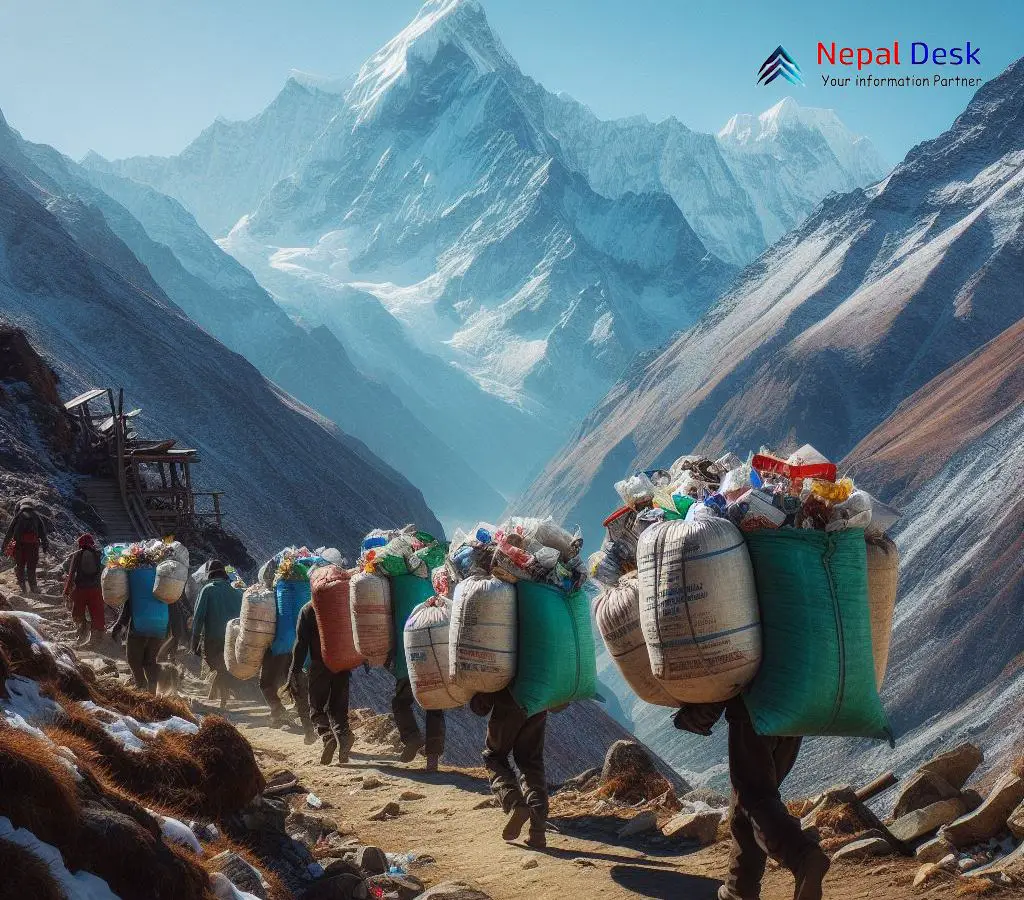Nepal Army's Cleaning Campaign 2024: Tackling Everest's Trash
Published Date

Published Date
Nepal Army's Mountain Cleaning Campaign 2024 aims to remove 10 tonnes of Everest trash, promoting sustainability and combating environmental impact.
⏱ 4 min read
In a monumental effort to address the human impact on the world's highest peak, the Nepal Army is spearheading its fourth environmental cleanup initiative, coined the Mountain Cleaning Campaign 2024, set to launch on April 14. This historic undertaking comes as Mount Everest, standing as Earth's tallest summit and a beacon for mountaineers remains tarnished by approximately 33 tonnes of trash left from previous climbing ventures spanning over two centuries. It wasn't until 1953 that Sir Edmund Hillary and Tenzing Norgay successfully ascended this behemoth, a feat that sparked countless expeditions since.
Major Aditya Karki will take command of a dedicated 12-person unit setting forth from Everest Base Camp (EBC), flanked by an experienced cadre of 18 Sherpas. Their departure will be ceremoniously initiated in Kathmandu by none other than General Prabhuram Sharma, the esteemed chief of the Nepal Army.
The target for the upcoming operation is ambitious: to retrieve an estimated 10 tonnes of refuse and five lost souls from Everest's daunting slopes. This substantial endeavor aims not only to cleanse the mighty Himalayas but also to take a firm stance against climate change-related issues.
During this expedition, the team's resolve will be put to the test as they traverse not just Everest but also its neighboring peaks Lhotse and Nuptse. Organic waste collected during their mission is slated for disposal at Namche Bazaar with the cooperation of the Sagarmatha Pollution Control Committee (SPCC), ensuring environmentally sound treatment. In contrast, non-biodegradable materials and human remains will find their final journey to Kathmandu.
In collaboration with various stakeholders including the Ministry of Forest and Environment, the Tourism Department, and the Nepal Mountaineers Association, the campaign reflects a collaborative approach to environmental stewardship in the Everest region.
In an auxiliary stride towards sustainability, recent legislation by the Government of Nepal mandates climbers to shoulder responsibility for their waste on these mighty peaks. Further complementing these regulations is the SPCC—a specialized entity dedicated to managing refuse in the Khumbu Region—which not only encompasses Sagarmatha National Park and its Buffer Zone but is also pivotal in preserving the quintessence of ever-popular Everest trekking trails.
To combat the escalating problem of waste on Mount Everest, an array of strategies can be examined:
- A proposed deposit system may be instituted, requiring climbers to leave a monetary deposit that would be refunded upon the safe removal of their trash from the mountain. This incentive-based model has mirrored the partial success seen on Tanzania's Mount Kilimanjaro.
- Linking expedition permits directly with waste management proposals could ensure climbers have a plan in place for disposing of waste responsibly. This might span mandatory training in waste collection or collaborations with organizations dedicated to cleaning the environment.
- The implementation of cutting-edge portable waste treatment technologies, alongside biodegradable equipment, may see a reduction in the refuse left on Everest.
- Education is pivotal, with potential mandatory training slated for climbers pre-expedition to reinforce the importance of a "leave no trace" philosophy and sound disposal methods.
- Heightened collaboration between expedition leaders, government bodies, and environmental conservation groups is key to setting up and maintaining potent waste management systems.
Let us look at some of the practices in other mountains to manage waste:
- On Mount Kilimanjaro, adhering to environmental stewardship is non-negotiable; climbers must transport all garbage beneath a designated altitude. Park employees rigorously inspect packs at certain intervals to enforce this rule and support the deposit scheme.
- Japan's approach to Mount Fuji sees climbers confined to specific paths while mandating the removal of all personal trash. Authorities orchestrate periodic clean-up sessions with assistance from volunteers and park officials.
- In Argentina's Aconcagua National Park, climbers purchase obligatory special waste bags which must be shown upon departure from the park, full and accounted for—a stringent policy that is strictly applied by park rangers.
Overall, to effectively combat the burgeoning waste problem on Mount Everest, a comprehensive strategy encompassing education, stringent regulations, technological innovation, and global collaboration is essential. Insights from successful waste management initiatives on other summits could prove invaluable in devising effective methodologies for Everest. It is important to recognize that efforts to address the accumulation of refuse on Everest are in progress, with a coalition of involved parties actively seeking to reduce the ecological footprint of mountaineering on this iconic peak.
